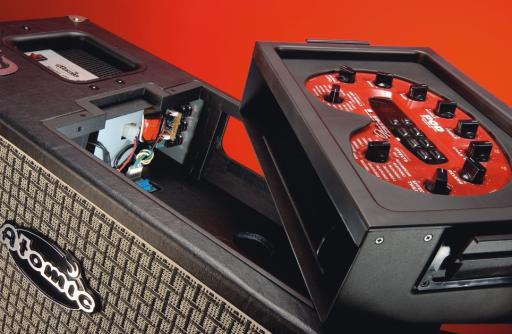MusicRadar Verdict
Any product that can make you sound more musical and inspire you to play more often is okay in our book - and that´s just what the Reactor does.
Pros
- +
Makes any digital modeller sound better. Cool design. Easy to use.
Cons
- -
The low volume use is lacking in presence.
MusicRadar's got your back



If you can, cast your mind back to winter 1998 when Line 6 launched its little kidney bean-shaped amp modeller. The emergence of POD kicked off the desktop digital amp modelling revolution. Now, its presence in the collective mind of guitar players is as accepted as the stalwart 4 x 12 cab.
Part of the initial excitement at POD´s arrival was the thought of being able to turn up at a gig with nothing more than your gig bag and the groovy red ‘bean´. A nice idea, but in practice POD just couldn´t provide a realistic ‘guitar-into-amp´ playing experience when wired through a PA. Nor did it perform satisfactorily when plugged into a regular combo because of the way guitar amps impart their tonal signature.
Having a new tool for sculpting cool amp tones that was confined to the studio was frustrating for some and, like many players who wanted to use this technology in a live situation, Atomic president Tom King thought he´d simply find an appropriate amp to make his digital modeller loud enough to rehearse and gig with at the guitar store.
Unfortunately, in his opinion, the offerings from the developing ‘modelling combos´ were disappointing and underpowered, and the perfect powered monitor for the job was conspicuously absent.
After encountering scores of players facing the same problem, King decided to take the only remaining option and commission a custom amp to be built. With the assistance of the tube amp guru and sound audio engineer extraordinaire, Harry Kolbe, the Atomic amplifier idea became reality and the company was born. After the positive feedback at the Summer NAMM 2003 product launch, the Atomic revolution was well underway.
To the audience the Atomic Reactor looks much like any other guitar combo. It´s only the player´s eye view that reveals the Reactor´s ingenious design. At the heart of the machine, the Reactor houses an 18-watt valve amplifier with no tone controls at all. Atomic likes to call it “the amp without an opinion”, and with this in mind the speaker choice and ported closed back cabinet are designed to amplify any preamp signal without adding any tonal colouring.
Guitarists will love the simplicity of the top panel, which offers nothing more taxing to the brain than the power switch and a jack input for your guitar. The only concession to more elaborate connectivity is the inclusion of a stereo effects loop on the rear of the amp. As well as providing an input for any rackmount or floor pedal processors, these sockets also offer true stereo operation when using two Reactor amplifiers simultaneously.
Behind the main power switch (there´s no standby) a ventilation grille for the twin EL84 power tubes works in conjunction with a rear-mounted fan to keep the tubes at the correct operating temperature. The noise when idling is extremely low.
The really clever bit about the Atomic Reactor is a removable DS-1 cassette or ‘docking unit´, which clips securely into the amplifier via locking handles on either side. This unit will house whichever digital desktop modeller you choose as a partner for the amp. Atomic ensures compatibility with all the currently available models by employing kits comprising a custom face template, custom length mounting screws and the appropriate power cable for each unit.
The beauty of this arrangement is that as modellers are continually upgraded and replaced, your faithful Reactor will always be able to accommodate them. Units that won´t fit in the docking bay - such as floormounted pedals and rack mounts - can still be plugged in via the FX-loop return on the rear, and the included blank template will ensure the Atomic looks tidy.
Once a digital amp-modeller is loaded into the DS-1 docking unit (which takes about two minutes), it can then be dropped in and out of the amp-top station in seconds - even with the amp powered up. All the wiring remains neatly in the cassette so, should you be lucky enough to own several amp-modelling products, you could potentially invest in a couple more DS-1 docking stations and ‘hot-swap´ ready-loaded units in seconds for maximum versatility.
For recording studios this feature is particularly useful, because the Atomic can be mic´d up - potentially offering scores of authentic-sounding amps at a fraction of the price and without the associated expense and storage problems.
In use
In order to give the Reactor a fair test, we tried it with just about every preamp we could find. Beginning with Line 6´s POD 2.0, the first thing that becomes apparent is that the tone gets rounded out in a pleasing way. Gone is the plastic-sounding sheen that plagues many amp modellers and in its place is a chunky, corky, airy amp sound that breathes new life into the tone.
Classic models like Marshall´s JCM 800 sound bigger and truer, while the Boogie, Matchless, Fender and Vox sounds all receive a better platform on which to perform. Alongside the Pod 2.0, the Behringer V-Amp and Vox Tonelab also perform superbly. To our ears, the best-sounding combination was with the Tonelab, which features a valve in its preamp stage.
The Reactor seems to help the modellers behave more like the amps they´re trying to emulate, acting like a tone translator to get the intended sound across better. At high volume, the Reactor behaves like a true tube amplifier and fattens up whatever model you put through it. The really exciting thing is that the playing experience becomes a lot more organic, allowing you to play the amp in the same way you would a regular valve combo.
At bedroom levels you can´t really hear the benefit of the valves, and we were left wondering why the presence seemed to almost disappear, but crank this thing up and the roar of a valve power stage can turn even the most modest modeller into a monster sounding amp.
What´s more you can achieve low volume feedback and get the reactance of the amp to work with you for solos and rhythm sounds. One of the common complaints with some of the big name modelling combos is the lack of clean headroom. Thankfully, there´s no such trouble here. The Atomic has room to spare up top leaving those Vox and Matchless models free to speak loud and clear with all the pristine sparkle and glassy brightness you´d expect.
MusicRadar is the number 1 website for music makers of all kinds, be they guitarists, drummers, keyboard players, djs or producers...
GEAR: We help musicians find the best gear with top-ranking gear round-ups and high- quality, authoritative reviews by a wide team of highly experienced experts.
TIPS: We also provide tuition, from bite-sized tips to advanced work-outs and guidance from recognised musicians and stars.
STARS: We talk to musicians and stars about their creative processes, and the nuts and bolts of their gear and technique. We give fans an insight into the actual craft of music making that no other music website can.

“It was the most disgusting thing I could ever imagine. It makes me sick just thinking of it!” The Cars’ guitarist Elliot Easton recalls the worst thing that ever happened to him on stage

“I really thought I was going to die... and it absolutely was so freeing”: Blink 182’s Mark Hoppus talks surviving cancer and his band’s resurrection

“From the very start of his social media rise Giacomo has been using other people’s compositions”: Social media guitar influencer Giacomo Turra accused of using other musicians’ arrangements and passing them off as his own










